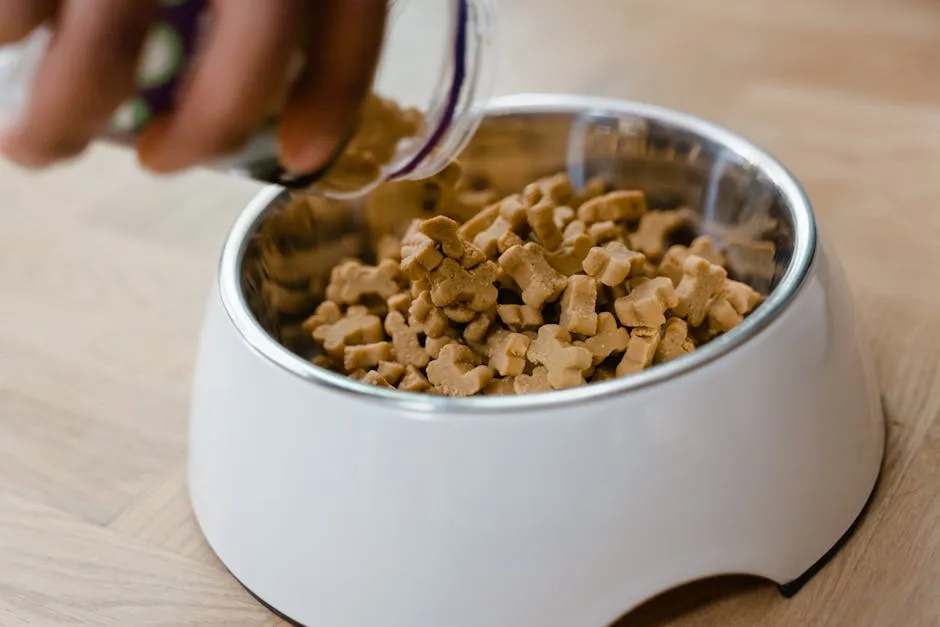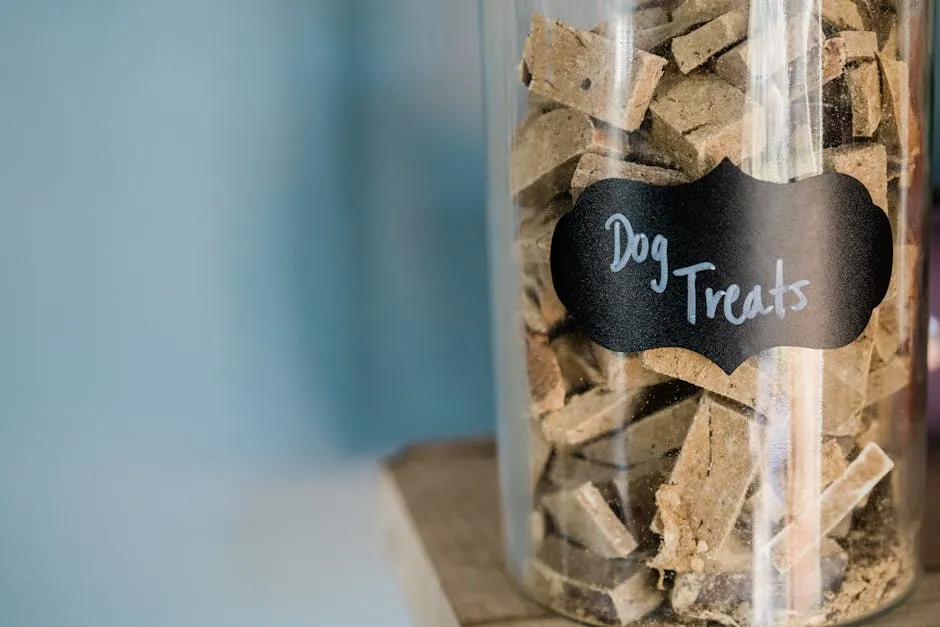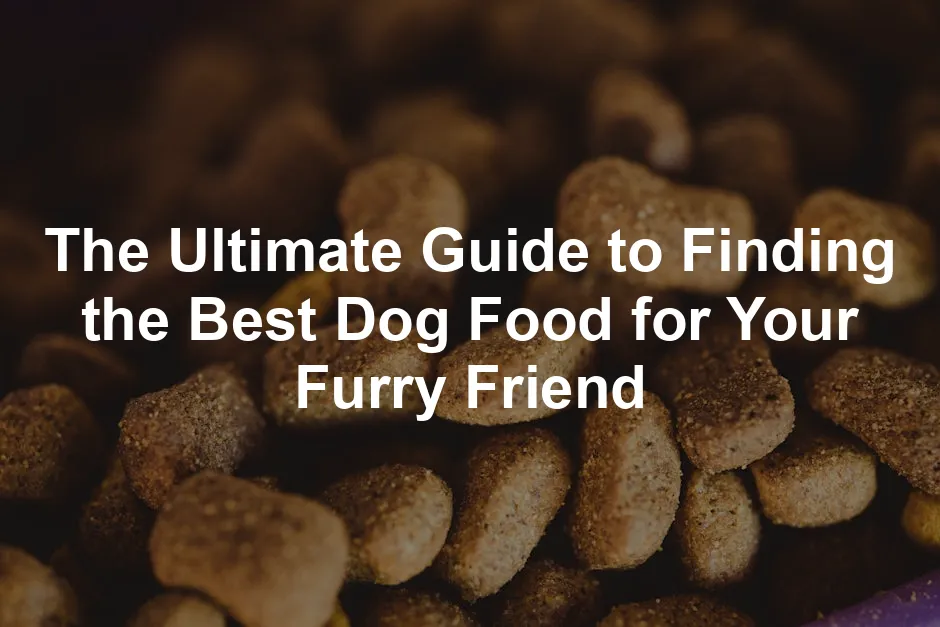Introduction
Picture this: you’re standing in the pet food aisle, utterly flabbergasted. The sheer number of dog food options rivals the number of flavors at your local ice cream shop! You’ve got kibble, wet food, raw food, and even options that sound like they belong on a fancy restaurant menu. “Do I want beef, chicken, or perhaps a delightful salmon soufflé?” You might even question if your dog is secretly a food connoisseur, judging your choices from afar.
Now, let’s face it—choosing the right food for your beloved pup is no laughing matter. It’s vital for their health and well-being. With the right nutrition, your dog can live their best life, filled with energy, shiny coats, and happy barks. But with so many choices, how do you pick? Fear not! This guide will break down the essential factors to consider when selecting dog food. We’ll also share expert recommendations and dispel some common misconceptions. So, whether your dog is a picky eater or a vacuum cleaner when it comes to food, we’ve got your back!

Summary of Key Points
When it comes to dog food, the variety is staggering. You can choose from dry kibble that stays fresh for ages, wet food that’s perfect for those picky eaters, or even raw and fresh options that may make your dog feel like royalty. Each type has its pros and cons, so it’s crucial to understand what best suits your furry friend.
First off, always consult with your veterinarian. They can provide tailored dietary advice based on your dog’s specific needs. This is especially important for dogs with health issues, allergies, or special dietary requirements.
Next, reading labels is key. Understanding the nutritional needs of your dog depends on their size, age, and health condition. Puppies need different nutrients than seniors, and large breeds often have unique considerations too. A little label-reading goes a long way in ensuring your dog gets balanced nutrition.
As for current trends, grain-free diets have gained popularity, but they’re not always the best choice for every dog. The rise of sustainable options like insect-based foods is also making waves in the market. These alternatives are better for the environment and can cater to dogs with allergies.

Speaking of options, if you’re looking for high-quality dry food, Royal Canin Dog Food is a fantastic choice. It’s formulated for specific breeds and life stages, ensuring your dog gets the nutrients they need to thrive. Your pup will thank you with wagging tails and slobbery kisses!
Finally, how do you spot the best brands? Look for quality ingredients and reputable manufacturers. A dog food brand that prioritizes transparency in their ingredients and nutritional claims is worth your investment. Always remember: just because a food is marketed as “premium” doesn’t mean it’s actually nutritious. Keep your eyes peeled for what really makes a dog food truly good!

How to Choose the Best Dog Food
Understanding Nutritional Needs
Choosing dog food isn’t simply about picking the fanciest bag. It’s about understanding what your dog requires at different life stages. Puppies are like little sponges, needing a diet rich in proteins and fats to fuel their rapid growth. They require more calories and nutrients than adult dogs. Look for puppy-specific formulas that contain high-quality protein sources.
Adult dogs, on the other hand, need a balanced diet to maintain their energy levels. They still require protein, but the amount should be proportionate to their activity level. High-quality fats are essential for energy, while carbohydrates can help with digestion.
Senior dogs have different needs as well. Their metabolism slows down, and they may need fewer calories. However, they require more fiber to aid digestion and maintain a healthy weight. Look for diets enriched with Omega-3 fatty acids, which can help with joint health. You can find more about this in our Guide to choosing the right dog food for senior dogs.
It’s essential to consider your senior dog’s unique nutritional needs when choosing their food. Learn more about it here.
In all cases, vitamins and minerals are crucial. Calcium and phosphorus support bone health, while antioxidants can combat aging. So remember, whether furry friends are young pups or wise seniors, nutrition is key!

Reading the Label
Ever tried to decipher a dog food label? It can feel like reading hieroglyphics. But fear not! Understanding labels is essential for making informed choices. Start by looking for the AAFCO (Association of American Feed Control Officials) statement. This indicates the food meets nutritional standards for dogs. If it says “complete and balanced,” you can breathe easy!
Next, check the ingredient list. Ingredients are listed by weight, so the first few items should be high-quality proteins, like chicken or beef. Avoid foods where the first ingredient is a filler, like corn or soy.
Nutritional adequacy statements are also vital. They tell you if the food is appropriate for your dog’s life stage. And don’t forget to pay attention to feeding guidelines! They provide insights on portion sizes based on your dog’s weight and activity level. Reading labels is like being a food detective—so put on your magnifying glass and get to work!

Types of Dog Food
Dry Dog Food
Let’s talk about kibble. It’s the classic choice, and for a good reason! Dry dog food is convenient and typically less expensive than wet food. Kibble can be stored easily and has a long shelf life. Plus, it helps keep your dog’s teeth clean—bonus points for dental health!
However, not all kibble is created equal. Look for brands that prioritize high-quality ingredients. Popular choices like Royal Canin and Hill’s Science Diet Dog Food have solid reputations for nutritional benefits. So, while kibble may be king, not every crown is equal!

Wet Dog Food
Now, if your pup is a picky eater, wet food might be your best bet. It’s often more palatable than dry food and can be easier to chew, especially for dogs with dental issues. The moisture content also helps keep your dog hydrated.
High-quality brands like Butternut Box and Forthglade Wet Dog Food offer tasty options packed with nutrients. They cater to various life stages and dietary needs, ensuring your dog gets a delicious meal. Wet food might come with a slightly higher price tag, but for those finicky eaters, it’s worth every penny!
In summary, when choosing dog food, consider your dog’s age, health, and preferences. Whether you opt for dry or wet food, ensure it meets their nutritional needs. After all, a happy dog equals a happy owner!

Raw and Fresh Dog Food
The raw food diet for dogs is a trend that has gained traction. It typically includes uncooked meat, bones, fruits, and vegetables. Advocates believe this mimics what wild canines would naturally consume. The benefits? Many dog owners report shinier coats, increased energy, and better digestion. However, there are potential risks. Raw diets can harbor harmful bacteria leading to health issues for both pets and humans. It’s crucial to consult a vet before making such a significant dietary change.
On the other hand, fresh dog food has become a popular alternative. It’s often cooked but made with whole ingredients, free from preservatives. Brands like The Farmer’s Dog Fresh Dog Food and Ollie Fresh Dog Food create customized meals based on your dog’s needs. These tailored recipes cater to specific dietary requirements, ensuring your dog gets the best nutrition possible. Fresh food can be a great way to keep your dog healthy and happy, but it often comes with a higher price tag.

Alternative Diets
Grain-free diets have seen a rise in popularity. While some dogs thrive without grains, others may not need this restriction. It’s essential to consult with a vet to determine if this diet suits your pup. Vegetarian dog foods are another option. They can be healthy, but they must meet AAFCO standards to ensure proper nutrition. Insect-based dog foods are also emerging, providing a sustainable protein source. These options can be beneficial for dogs with meat allergies, but as always, check with your veterinarian for the best dietary fit for your furry friend.

Best Premium Options
When it comes to dog food, premium brands often stand out like a shiny trophy. These high-end options use top-notch ingredients, and let’s be honest, your dog deserves the best! Brands like Orijen and Acana pride themselves on utilizing fresh, regional ingredients. They often feature high meat content—up to 85% in some formulas! A diet rich in quality proteins helps your pup maintain muscle mass and energy levels.
Not only do premium options boast better ingredients, but they also lack artificial additives and fillers. This means no corn, soy, or meat by-products. Instead, they offer real meats, wholesome grains, and nutrient-rich vegetables. The result? Happier and healthier dogs with shiny coats and wagging tails. Investing in premium dog food can lead to fewer vet visits and a longer lifespan for your furry friend. Now that’s a win-win!

Best for Active Dogs
Is your dog more energetic than a toddler on a sugar rush? Then they need food that can keep up! Look for dog food specially formulated for active pups. Brands like Purina Pro Plan Sport Dog Food and Hill’s Science Diet Active offer high-protein formulas that support muscle health and stamina.
These foods often include essential nutrients like Omega-3 and Omega-6 fatty acids, which are great for joint health. Plus, they contain a balanced mix of carbohydrates to fuel those zoomies around the yard. It’s like giving your dog a power-up in a video game! With the right nutrition, your active dog will be ready to conquer the great outdoors—one stick at a time.

Common Myths About Dog Food
When it comes to dog food, misinformation runs rampant. Let’s tackle some common myths and set the record straight!
Grain-free is always better. This myth has gained traction in recent years. While some dogs may benefit from a grain-free diet due to allergies, most dogs can digest grains just fine. In fact, grains like brown rice and barley provide essential nutrients and energy. So, unless your dog has a clear allergy, there’s no need to jump on the grain-free bandwagon.
Raw food is the healthiest option. The raw food diet has its fans, but it’s not the end-all-be-all for canine nutrition. Many veterinarians warn against raw diets, citing risks of harmful bacteria and nutrient imbalances. Commercial dog food is formulated to meet nutritional needs, providing a balanced diet without the risks associated with raw feeding. Stick with reputable brands that prioritize safety and nutrition.
All dog food brands are the same. This couldn’t be further from the truth! Dog food brands vary widely in ingredient quality, nutritional content, and manufacturing practices. Some brands prioritize high-quality, whole ingredients, while others may focus on cost-cutting fillers. Always read labels carefully and consult with your vet to find the best fit for your pup.

Separating fact from fiction is essential for your dog’s health. By understanding these myths, you can make informed choices that benefit your furry friend.
FAQs
How much should I feed my dog?
Feeding your dog isn’t a one-size-fits-all scenario. Several factors come into play. Start with your dog’s weight. Hefty breeds need more fuel than pint-sized ones. Age matters too. Puppies are like bottomless pits, while seniors may be a bit more delicate. Don’t forget activity level! Couch potatoes require fewer calories than a dog that’s practically a furry tornado. Always check the feeding guidelines on your dog food packaging. They provide a great starting point. If in doubt, consult your vet. They know your dog best!
Is grain-free dog food safe?
Grain-free dog food has been a hot topic in recent years. Many dog owners opt for it, thinking it’s the healthier choice. However, recent studies have raised eyebrows. The FDA has investigated a potential link between grain-free diets and dilated cardiomyopathy (DCM) in some dogs. It’s not the grains themselves that are the enemy, but rather some ingredients used in grain-free formulas, like certain legumes. If you suspect your dog has dietary sensitivities, chat with your vet before making any drastic changes.
Can I mix different types of dog food?
Mixing dog food types can be a great way to keep mealtime interesting. However, make the transition carefully. Start by gradually introducing the new food over 5-7 days. This way, your dog’s tummy can adjust. Begin with a small mix of the new food and increase it slowly while decreasing the old food. If your dog shows any signs of digestive distress, slow down the process. Consistency is vital, but variety can spice up your pup’s dining experience!
What should I look for in a dog food label?
Reading dog food labels can feel like deciphering an ancient script. Start with the AAFCO statement. This indicates that the food meets established nutritional standards. Next, check the ingredients list. High-quality protein should be at the top, followed by wholesome fruits and veggies. Watch out for fillers like corn and soy—those don’t pack much nutritional punch. Lastly, look for feeding guidelines. They help you gauge proper portion sizes based on your dog’s weight and activity level. A little label literacy goes a long way!
Are raw diets safe for dogs?
Raw diets are a hot topic among dog owners. Some swear by them, claiming shiny coats and boundless energy. But hold your horses! While raw feeding can be beneficial, it also comes with risks. Bacteria like Salmonella and E. coli can be lurking in raw meat, posing health risks for both your dog and your family. Additionally, balancing a raw diet to ensure it meets all nutritional needs can be tricky. Before diving into the raw food trend, have a heart-to-heart with your vet. They’ll help you navigate the pros and cons.
As you navigate this dog food jungle, don’t forget to grab a Dog Food Storage Container to keep those kibble fresh and tasty. Because nothing says “I love you” like a well-stored meal!

Please let us know what you think about our content by leaving a comment down below!
Thank you for reading till here 🙂
All images from Pexels





